The Grey-Shanked Douc Langur (Pygathrix cinerea), classified under the Animalia kingdom and Chordata phylum, was discovered in 1997 in Vietnam. Native to the region from Quang Nam to Binh Dinh, these primates inhabit tropical hill forests at altitudes ranging from 200 to 1500 meters. Recognized for their distinctive grey fur with white markings, these langurs are a rare and endangered species facing severe threats due to hunting and habitat destruction. Urgent conservation measures are crucial to safeguard the dwindling population of this captivating primate.
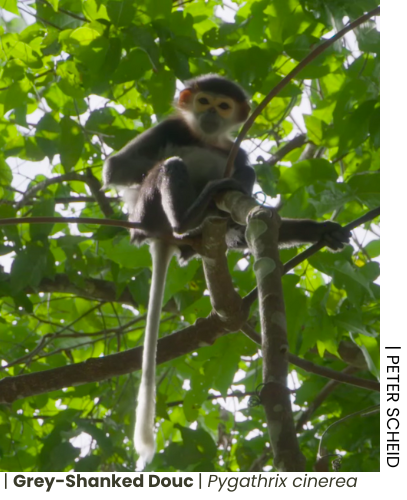
Are you looking for Wildlife Tours in Vietnam?
WANEE VIETNAM is the right place for the "Wildlife Tours in Vietnam", we specialize in Birding, Wildlife watching, Herping, Photography-tours and general Edu-tours by our experts.
Taxonomy and Classification of the Grey-Shanked Douc Langur:
Regnum: Animalia
Phylum: Chordata
Class: Mammalia
Ordo: Primates
Familiar: Cercopithecidae
Genus: Pygathrix
Species: Pygathrix cinerea
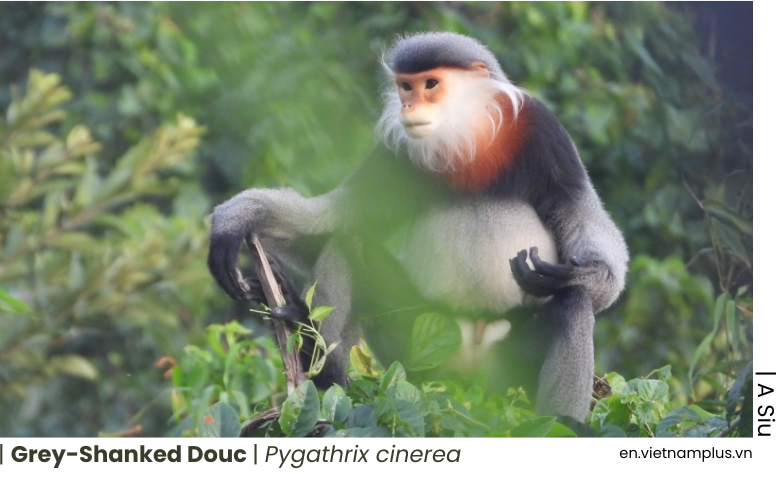
The Grey-Shanked Douc Langur (Pygathrix cinerea) is a douc species native to various Vietnamese provinces, including Quảng Nam, Quảng Ngãi, Bình Định, Kon Tum, and Gia Lai. Classified as Critically Endangered, these langurs share a close resemblance to P. nemaeus. They exhibit a light grey color with a pale underside, black hands and feet, and dark grey shins.
The face is brownish-orange on top, featuring a white chin, while the throat has a white base with an orange-brown collar. With males averaging 10.9 kg and females around 8.2 kg, the population faces severe threats such as deforestation and hunting for meat, ‘medicine,’ and the pet trade. The decline in population is estimated at over 80% over three generations, with predictions indicating a continued or slightly higher rate of decline in the next 36 years.
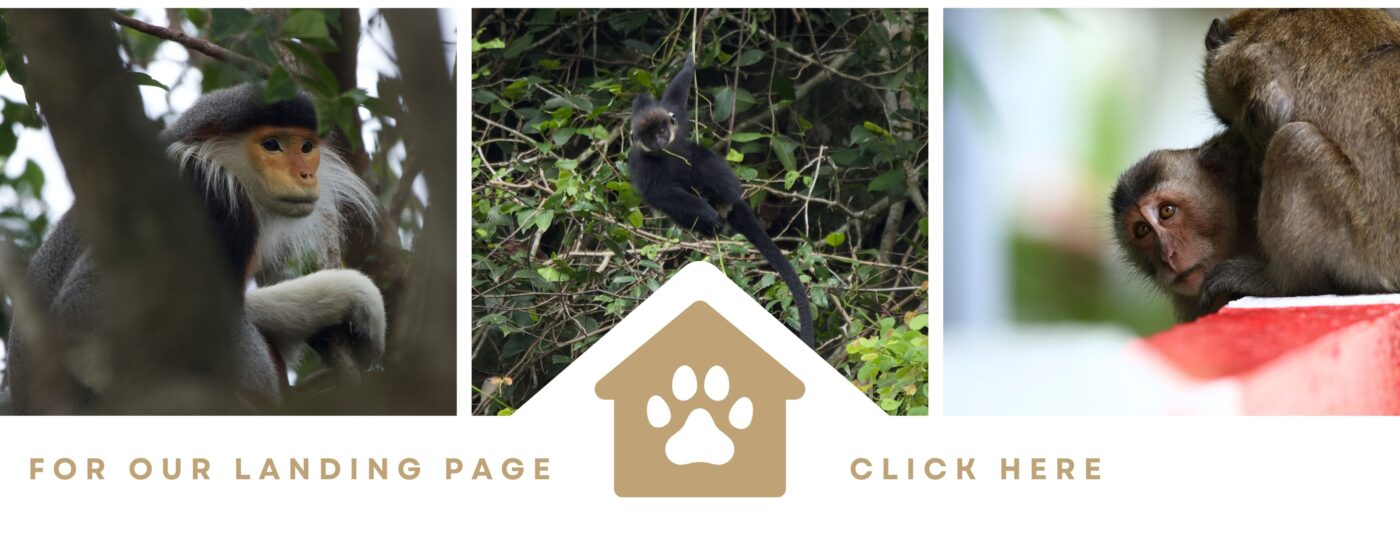
Habitat and Distribution of the Grey-Shanked Douc Langur:
The Grey-Shanked Douc Langur, a terrestrial species, primarily inhabits evergreen and semi-evergreen forests, particularly in lower montane regions and highly degraded forests within the altitude range of 900 to 1,300 meters above sea level (asl) (Ha Thang Long 2004, 2007, 2009). Displaying arboreal tendencies, the species is predominantly folivorous, with a diet comprising young leaves (49.5%), mature leaves (9.3%), and fruits, seeds, and flowers (40%) (Nadler et al. 2003; Ha Thang Long 2009).
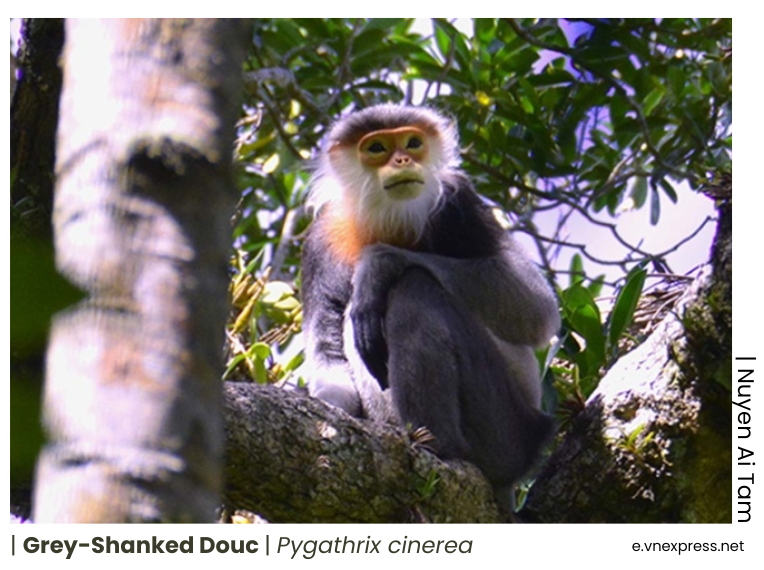
Noteworthy seasonal variations in diet and activity have been observed, with a higher consumption of fruit during the wet season. Activity budgets also differ, with increased resting and socializing during the wet season and more movement during the dry season. Typically found in one male–multi-female groups, occasional gatherings of multiple groups and all-male groups also occur. The distribution of this species spans Central Vietnam, encompassing Quảng Nam, Quảng Ngãi, Bình Định, Kon Tum, and Gia Lai.
Behavior and Social Structure of the Grey-Shanked Douc Langur:
Much like their Red-Shanked counterparts, the Grey-Shanked Douc Langur exhibits diurnal behavior and thrives in arboreal environments, showcasing agility in traversing the forest canopy through jumping and brachiating. Historically, they formed sizable groups of up to fifty individuals, but contemporary observations reveal reduced group sizes ranging from 4 to 15 members. Males take on dominant roles within these groups, with observed hierarchies, especially in captive settings. The lifestyle of the Black-Shanked Douc Langur encompasses an arboreal, zoochoric, scansorial, and terrestrial nature, lacking the migratory patterns seen in some species.
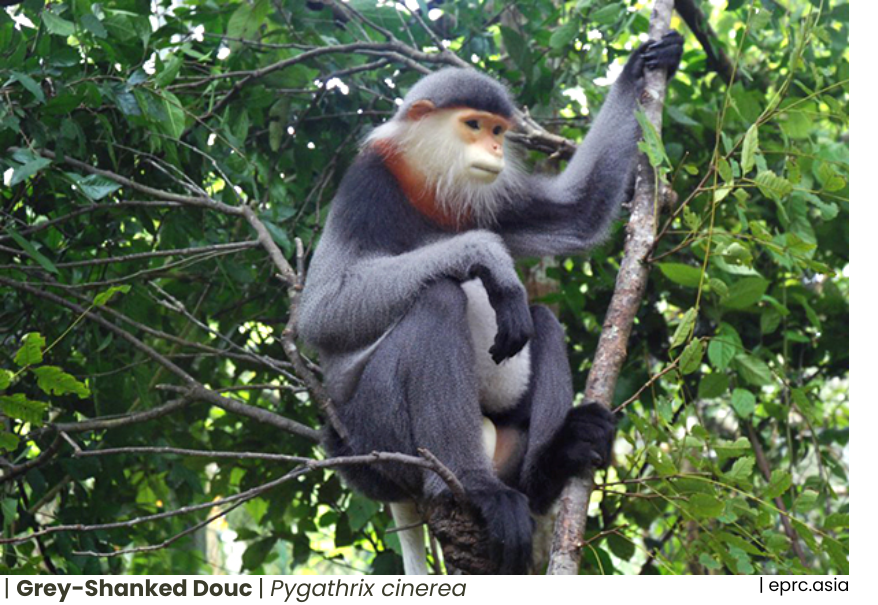
Grey-Shanked Douc Langurs, also diurnal and primarily arboreal, navigate the tree canopies through jumping and brachiating. While historically found in large groups, their numbers have dwindled to 4 to 15 individuals. Males hold dominance within these groups, a hierarchy observed even in captivity.
Communication in grey-shanked doucs involves touch, visual cues, and sounds. Growls serve as expressions of aggression, conveying threats or warnings. A soft twitter sound indicates submission. Grooming rituals contribute to parasite removal and group bonding, often preceding nightly rest. Intraspecific interactions may involve sparring, where individuals engage in slapping, pulling, and grabbing. Visual communication incorporates facial expressions like grimacing for submissiveness, play faces during group interactions, and staring for curiosity or aggression. These expressions also play a role in courtship, where males use facial cues to signal readiness for copulation.
Grey-Shanked Langurs maintain a primarily folivorous diet, complemented by seeds, fruits, and flowers, with a preference for young leaves and unripened fruit.
Reproductive Biology of the Grey-Shanked Douc Langur:
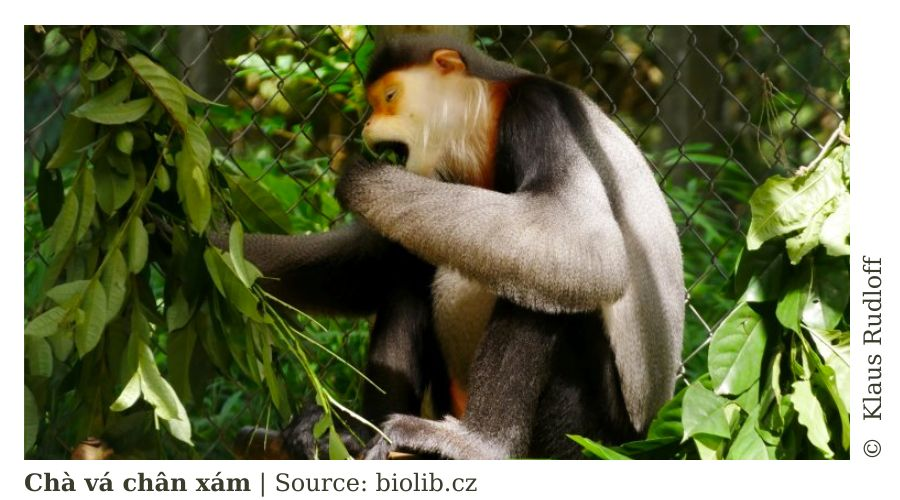
The breeding season typically spans from August to December, with a gestation period ranging from 165 to 190 days. During courtship, potential mates engage in a distinctive ritual using facial expressions to signal readiness for copulation. This involves thrusting the jaw forward, shaking the head, and raising and lowering the eyebrows, with both individuals reciprocating these actions. The female then presents herself to the male.
Births commonly occur from January to August, coinciding with the fruiting season. A single offspring is born, weighing between 500 g to 720 g. Females attain sexual maturity around four years of age.
Conservation Status:

The grey-shanked douc langur (Pygathrix cinerea) is classified as critically endangered according to the IUCN Red List. The population estimate in 2004 ranged from 550 to 700 individuals, and a significant discovery in 2016 identified an additional population of over 500 individuals in Central Vietnam, bringing the total to around 1000.
The species faces extensive threats, notably hunting for bushmeat, traditional medicine, and the exotic pet trade. Their bones are exploited to produce “monkey bone balm,” believed to have medicinal properties. Additionally, the Vietnam War and habitat destruction, fueled by deforestation and climate change, have contributed to a sharp population decline.
Legal measures are in place to protect their habitat and curb hunting, although enforcement has historically been inconsistent. Notably, in 2016, reports emerged of grey-shanked doucs being tortured and killed by Vietnamese troops, highlighting ongoing challenges.
Conservation efforts involve comprehensive strategies. The Frankfurt Zoological Society’s Vietnam Primate Conservation Program conducts a long-term study in Gia Lai Province, focusing on distribution, behavior, and population dynamics. The Endangered Primate Rescue Center oversees a captive breeding program, contributing to conservation education.
The grey-shanked douc langur’s presence in several protected areas in Vietnam, including Song Thanh Nature Reserve, Ngoc Linh Nature Reserve, Kon Ka Kinh National Park, and Kon Cha Rang Nature Reserve, offers some level of protection. However, hunting and habitat disturbance persist.
Research priorities include assessing population size, distribution, and trends, understanding harvest impacts and livelihoods, identifying threats, and formulating targeted conservation actions. Monitoring efforts are crucial for tracking population trends.
To address conservation challenges effectively, action plans include establishing protected areas, managing habitats, implementing species management plans, and enhancing education and awareness programs at the provincial level. Ensuring compliance with existing laws and exploring additional protective measures are integral components of the conservation strategy. Ongoing research is fundamental for informed decision-making and the successful preservation of the grey-shanked douc langur.
Why don’t you visit Vietnam on a primate discovery tour? Click here.
Conclusion:
In conclusion, the Grey-Shanked Douc Langur (Pygathrix cinerea) faces imminent extinction, marked as critically endangered on the IUCN Red List. Native to Vietnamese provinces, they share a close resemblance to P. nemaeus. With a dwindling population and threats from deforestation and hunting, conservation efforts are critical. The species’ habitat in evergreen forests and its arboreal behavior emphasize its vulnerability.
Communication involves touch, visual cues, and sounds, while grooming and sparring are crucial for group dynamics. Reproductively, courtship is marked by distinctive facial expressions. Conservation initiatives, including legal safeguards, research, and education programs, aim to secure their survival, yet challenges persist. The fate of the Grey-Shanked Douc Langur highlights the delicate balance needed for the coexistence of humanity and nature.
Dalat Plateau Birding Herping and Wildlife Tours
The Dalat Plateau, rising 2,000 meters above sea level, is one of Vietnam’s most important [...]
Cat Tien National Park Birding Herping and Wildlife Tours
Cat Tien National Park tours offer an unforgettable experience with sightings of Germain’s Peacock Pheasant, [...]
Western Black Crested Gibbon – Nomascus concolor
Nestled within the verdant landscapes of Vietnam, the Western Black Crested Gibbon (Nomascus concolor) emerges [...]
Northern White-cheeked Gibbon – Nomascus leucogenys
The northern white-cheeked gibbon (Nomascus leucogenys) is a Critically Endangered gibbon species indigenous to South [...]
Northern Yellow-cheeked Crested Gibbon – Nomascus annamensis
The Northern Yellow-Cheeked Crested Gibbon, or Nomascus annamensis, is an exclusive primate species found in [...]
Eastern Black Crested Gibbon – “Cao-vit Gibbon” – Nomascus nasutus
Nestled within the dense, emerald-green forests of Vietnam, the Eastern Black Crested Gibbon (Nomascus nasutus), [...]